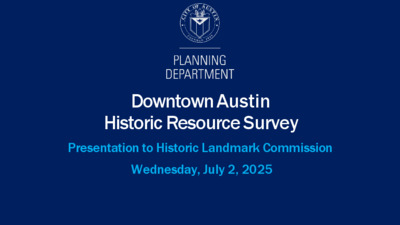02.0 - Briefing on the Downtown Austin Historic Resource Survey — original pdf
Backup

Downtown Austin Historic Resource Survey Presentation to Historic Landmark Commission Wednesday, July 2, 2025 Historic Preservation Office Planning Department Project Sponsor HHM & Associates Preservation Consulting Firm Agenda • What are Historic Resource Surveys? • Survey Background & Methodology • Survey Recommendations • Frequently Asked Questions • Timeline & Next Steps • Future Survey Projects Historic Resource Surveys ▪ Document buildings, structures, and objects that are at least 50 years old ▪ Evaluate architectural character and historic associations ▪ Recommend eligibility for historic designations, including: – Local landmark zoning (H) – Local historic district zoning (HD) – Individual National Register listing – National Register historic district listing ▪ Are a foundational tool for historic preservation and should be updated every ten years 4 Historic Resource Surveys ▪ Support City HPO staff evaluating permit and designation applications ▪ Support property owners seeking historic designation ▪ Identify heritage tourist sites/districts and areas of importance to underrepresented communities 5 Survey Background & Methodology ▪ Downtown Austin was last surveyed in 1984 ▪ 1,964 resources on 1,553 parcels surveyed ▪ Boundaries: – Enfield Rd/ MLK Jr. Blvd (north) – IH-35 (east) – Lady Bird Lake (south) – MoPac (west) 6 MLK Jr. Blvd Enfield Rd MoPac IH-35 Lady Bird Lake Step 1: Fieldwork Preparation ▪ Data integrated into geospatial database as basemap: – Travis County Appraisal District – City of Austin historic zoning – National Register of Historic Places – Historic maps 8 Step 2: Field Survey ▪ Documented all resources constructed by 1975 ▪ Both primary and auxiliary resources documented ▪ Two photographs taken of each resource ▪ Architectural character and physical integrity recorded 9 Step 3: Post-Survey Processing 1. Compile all historic research findings, including occupancy history 2. Identify historical themes and trends 3. Evaluate eligibility for local and National Register designation 4. Assess potential historic district boundaries 10 Survey Recommendations Local Historic Districts Historic Landmarks within Local Historic Districts 19% 50% 50% 81% Surveyed resources within an eligible or listed local historic district Other resources Surveyed resources eligible for landmark designation 11 Sample of Resources Eligible for Historic Designation 12 Recommended Historic District Boundaries 13 Frequently Asked Questions Will this survey result in automatic zoning or tax changes? Will voluntary owner-initiated historic designation result in zoning or tax changes? No. The survey makes only advisory recommendations for historic resource eligibility. Designation at the local level adds H or HD to the base zoning and can unlock property tax reduction incentives. Alterations must follow City design standards. Designation at the federal level does not involve a zoning change and makes some properties eligible for rehabilitation tax credits. City provides advisory reviews of alterations. 14 Timeline & Next Steps December 18, 2023 In-person kick-off at the Carver Branch Library to share information about the survey March 20, 2024 Briefing to Downtown Commission May 13, 2024 Virtual public meeting to share information about the survey March 5, 2025 Briefing to Historic Landmark Commission March 19, 2025 Briefing to Downtown Commission March 26, 2025 Public feedback period opens (7 weeks) April 16, 2025 Virtual public meetings to share information and answer questions May 9, 2025 Public feedback period closes June 12, 2025 Briefing to City Council Housing and Planning Committee June 18, 2025 Final survey delivered July 2, 2025 Briefing to Historic Landmark Commission 15 Future Survey Projects ▪ Continual and consistent historic resource surveys lay essential groundwork for historic preservation and are an invaluable part of all major cities’ planning programs. ▪ Update and expansion of 2016 East Austin Historic Resource Survey (pending FY2026 funding) ▪ Prioritization of areas with high development pressure ▪ Determination of funding 16 Thank You